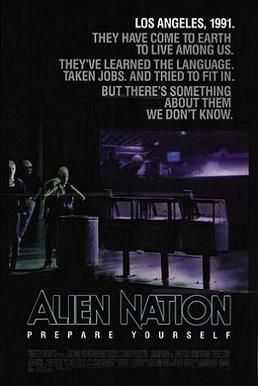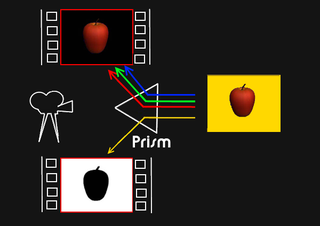A film crew is a group of people, hired by a production company, for the purpose of producing a film or motion picture. The crew is distinguished from the cast, as the cast are understood to be the actors who appear in front of the camera or provide voices for characters in the film. The crew is also separate from the producers, as the producers are the ones who own a portion of either the film studio or the film's intellectual property rights. A film crew is divided into different departments, each of which specializes in a specific aspect of the production. Film crew positions have evolved over the years, spurred by technological change, but many traditional jobs date from the early 20th century and are common across jurisdictions and filmmaking cultures.
Mise-en-scène is the stage design and arrangement of actors in scenes for a theatre or film production, both in the visual arts through storyboarding, visual themes, and cinematography and in narrative-storytelling through directions. The term is also commonly used to refer to single scenes that are representative of a film.

Chroma key compositing, or chroma keying, is a visual-effects and post-production technique for compositing (layering) two or more images or video streams together based on colour hues. The technique has been used in many fields to remove a background from the subject of a photo or video – particularly the newscasting, motion picture, and video game industries. A colour range in the foreground footage is made transparent, allowing separately filmed background footage or a static image to be inserted into the scene. The chroma keying technique is commonly used in video production and post-production. This technique is also referred to as colour keying, colour-separation overlay, or by various terms for specific colour-related variants such as green screen or blue screen; chroma keying can be done with backgrounds of any colour that are uniform and distinct, but green and blue backgrounds are more commonly used because they differ most distinctly in hue from any human skin colour. No part of the subject being filmed or photographed may duplicate the colour used as the backing, or the part may be erroneously identified as part of the backing.

An animator is an artist who creates multiple images, known as frames, which give an illusion of movement called animation when displayed in rapid sequence. Animators can work in a variety of fields including film, television, and video games. Animation is closely related to filmmaking and like filmmaking is extremely labor-intensive, which means that most significant works require the collaboration of several animators. The methods of creating the images or frames for an animation piece depend on the animators' artistic styles and their field.

Cinematography is the art of motion picture photography.
Visual effects is the process by which imagery is created or manipulated outside the context of a live-action shot in filmmaking and video production. The integration of live-action footage and other live-action footage or CGI elements to create realistic imagery is called VFX.

In the United States, Canada and the United Kingdom, grips are camera support equipment technicians in the filmmaking and video production industries. They constitute their own department on a film set and are directed by a key grip. Grips have two main functions: The first is to work closely with the camera department to provide camera support, especially if the camera is mounted to a dolly, crane, or in an unusual position, such as the top of a ladder. Some grips may specialize in operating camera dollies or camera cranes. The second function is to work closely with the electrical department to create lighting set-ups necessary for a shot under the direction of the director of photography.
Grips' responsibility is to build and maintain all the equipment that supports cameras. This equipment, which includes tripods, dollies, tracks, jibs, cranes, and static rigs, is constructed of delicate yet heavy duty parts requiring a high level of experience to operate and move. Every scene in a feature film is shot using one or more cameras, each mounted on highly complex, extremely expensive, heavy duty equipment. Grips assemble this equipment according to meticulous specifications and push, pull, mount or hang it from a variety of settings. The equipment can be as basic as a tripod standing on a studio floor, to hazardous operations such as mounting a camera on a 100 ft crane, or hanging it from a helicopter swooping above a mountain range.
Good Grips perform a crucial role in ensuring that the artifice of film is maintained, and that camera moves are as seamless as possible. Grips are usually requested by the DoP or the camera operator. Although the work is physically demanding and the hours are long, the work can be very rewarding. Many Grips work on both commercials and features.

Traditional animation is an animation technique in which each frame is drawn by hand. The technique was the dominant form of animation in cinema until the end of the 20th century, when there was a shift to computer animation in the industry, specifically 3D computer animation.
In filmmaking, a double is a person who substitutes for another actor such that the person's face is not shown. There are various terms associated with a double based on the specific body part or ability they serve as a double for, such as stunt double, "dance double", "butt double" and "hand double".

Alien Nation is a 1988 American science fiction action film written by Rockne S. O'Bannon and directed by Graham Baker. The ensemble cast features James Caan, Mandy Patinkin, and Terence Stamp. Its initial popularity inaugurated the beginning of the Alien Nation media franchise. The film depicts the assimilation of the "Newcomers", an alien race settling in Los Angeles, much to the initial dismay of the local population. The plot integrates the neo-noir and buddy cop film genres with a science fiction theme, centering on the relationship between a veteran police investigator (Caan) and an extraterrestrial (Patinkin), the first Newcomer detective. The duo probe a criminal underworld while attempting to solve a homicide.
Filmmaking or film production is the process by which a motion picture is produced. Filmmaking involves a number of complex and discrete stages, beginning with an initial story, idea, or commission. Production then continues through screenwriting, casting, pre-production, shooting, sound recording, post-production, and screening the finished product before an audience, which may result in a film release and exhibition. The process is nonlinear, as the director typically shoots the script out of sequence, repeats shots as needed, and puts them together through editing later. Filmmaking occurs in a variety of economic, social, and political contexts around the world, and uses a variety of technologies and cinematic techniques to make theatrical films, episodic films for television and streaming platforms, music videos, and promotional and educational films.

Corpse Bride is a 2005 stop-motion animated musical fantasy film directed by Mike Johnson and Tim Burton from a screenplay by John August, Caroline Thompson, and Pamela Pettler, based on characters created by Burton and Carlos Grangel. The plot is set in a fictional Victorian era village in England. Johnny Depp leads the cast as the voice of Victor, while Helena Bonham Carter voices Emily, the title bride. An international co-production between the United States and United Kingdom and produced by Tim Burton Productions and Laika Entertainment, Corpse Bride is the first stop-motion feature film directed by Burton and his first stop-motion film distributed by Warner Bros. Pictures after previously producing 1993's The Nightmare Before Christmas and 1996's James and the Giant Peach for The Walt Disney Company.

Living in Oblivion is a 1995 American independent satirical black comedy film written and directed by Tom DiCillo, and starring Steve Buscemi, Catherine Keener, Dermot Mulroney, Danielle von Zerneck, James LeGros and Peter Dinklage in his film debut. The film won the Waldo Salt Screenwriting Award at the 1995 Sundance Film Festival for DiCillo. It received critical acclaim.

Rembrandt lighting is a standard lighting technique that is used in studio portrait photography and cinematography; it is also used in contrast with butterfly lighting It can be achieved using one light setup and a reflector, or two lights, and is popular because it is capable of producing images which appear both natural and compelling with a minimum of equipment. Rembrandt lighting is characterized by an illuminated triangle under the eye of the subject on the less illuminated side of the face. It is named for the Dutch painter Rembrandt, who occasionally used this type of lighting.

The sodium vapor process is a photochemical film technique for combining actors and background footage. It originated in the British film industry in the late 1950s and was used extensively by Walt Disney Productions in the 1960s and 1970s as an alternative to the more common bluescreen process. Wadsworth E. Pohl is credited with the invention or development of both of these processes, and received an Academy Award in 1965 for the sodium vapor process as used in the film Mary Poppins.

My Scene was an American series of fashion dolls that Mattel released in 2002. They were discontinued in the US in 2008, and worldwide in 2011. Mattel's Barbie character was one of the dolls in the toy line. The My Scene dolls' bodies were slim, similar to earlier Barbie dolls, but their heads were larger. The New York Times described their features as "exaggerated lips and bulging, makeup-caked eyes." My Scene were designed to appeal to the tween market and compete with the Bratz dolls from MGA Entertainment.
Shot-for-shot is a way to describe a visual work that is transferred almost completely identically from the original work without much interpretation.
Articles related to the field of motion pictures include:
This glossary of motion picture terms is a list of definitions of terms and concepts related to motion pictures, filmmaking, cinematography, and the film industry in general.
The special effects of the 1991 American science fiction action film Terminator 2: Judgment Day were developed by four core groups: Industrial Light & Magic (ILM), Stan Winston Studio, Fantasy II Film Effects, and 4-Ward Productions. Pacific Data Images and Video Images provided some additional effects.










